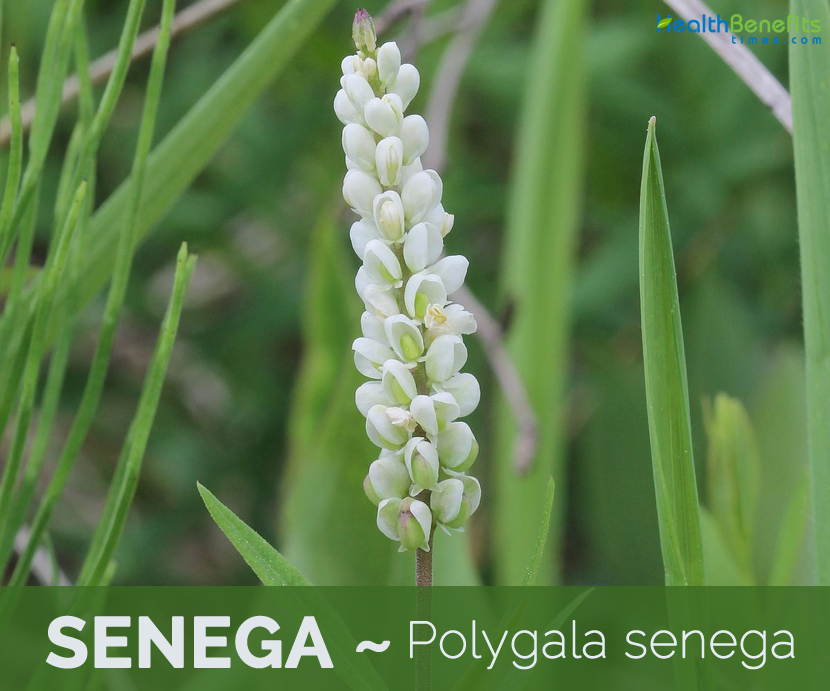| Senega Quick Facts | |
|---|---|
| Name: | Senega |
| Scientific Name: | Polygala senega |
| Origin | North America |
| Colors | Light yellowish grey to brownish grey (Root) |
| Shapes | Twisted and conical. Size differ from the thickness of a straw to that of the little finger |
| Taste | Bitter, pungent taste |
Plant Description
Senega is a small perennial herb that grows about half a meter in height. The plant is found growing in upland gravel prairies, hill prairies, savannas, wooded slopes along rivers or lakes, and abandoned fields. The plant prefers to grow in thin, rocky, usually calcareous soils. Root is twisted and conical. Size range from the thickness of a straw to that of the little finger has as its distinguishing mark a projecting line, along its concave side. Roots are normally light yellowish grey to brownish grey colored. The root sends up a number of smooth, slender, erect stems (as many as 15 or 20 or more), sometimes slightly tinged with red, from 6 inches to a foot in height, and generally unbranched.
Leaves & Fruit
Small, lance-shaped leaves are alternately arranged. The lower leaves are reduced and scale-like. The flowering spikes are borne in May and June on the ends of the stems and consist of numerous, small pinky-white flowers that are crowded on to a narrow, terminal spike from 1 to 2 inches long. The lower flowers develop first and have already fruited when the upper flowers open. Fruit is a capsule containing two hairy black seeds.
Traditional uses and benefits of Senega
- Cherokee used it as an expectorant and a diuretic, and for inflammation, croup, and common cold.
- Chippewa used preparations of the root to treat convulsions and bleeding wounds.
- Cree chewed the root for sore throat and toothache.
- Seneca may have been encouraged to use the tortuous root to treat snakebite by its resemblance to the tail of a rattlesnake.
- It was marketed as a treatment for pneumonia.
- It is ground and made into patent medicines, mainly remedies for respiratory complaints.
- It is added to cough syrups, teas, lozenges, and gargles.
- It is still used in modern herbalism where it is valued mainly as an expectorant and stimulant to treat bronchial asthma, chronic bronchitis and whooping cough.
- Root contains triterpenoid saponins; these promote the clearing of phlegm from the bronchial tubes.
- Root is antidote, cathartic, diaphoretic, diuretic, emetic, expectorant, sialagogue, stimulant.
- It was used by the North American Indians in the treatment of snake bites.
- It has been found of use in the treatment of various respiratory problems including pleurisy and pneumonia.
- Tea made from the bark has been drunk in order to bring about a miscarriage.
- Dried root is used as a stimulating expectorant.
- Root has been used to treat snakebites; it is chewed and applied to the bite.
- Extracts of the senega root may also be used as a gargle and mouthwash for the treatment of catarrh.
- In 19th century, senega root was used in the form of an expectorant in cough remedies.
- Herb is used to treat a number of health conditions, including respiratory tract inflammation, bronchitis, emphysema, and tracheitis or inflammation of the trachea.
- It has been found that the saponins present in senega root have the promise to treat type II diabetes.
- It is believed that this herb encourages perspiration and also promotes the secretion of saliva.
- It is given as syrup to children with wet, phlegmy coughs.
- It is used to treats mild constipation, and has a diuretic action.
Ayurvedic Health benefits of Senega
- Sore Throat: Use as a mouthwash and gargle for sore throat.
- Night Sweat: Take equal amount of Liquorice, Chinese date, Turmeric, Senega Snakeroot, Japanese Rush and wheat. Grind them together. Have half tsp twice a day.
- Reproductive problems of Males: Ginseng Korean, Astragalus, Dong Quai, Rehmannia, Cuscuta Chinensis, Goji berry, fennel, Zanthoxylum Piperitum, Morinda Officinalis, Cornus Officinalis, Polyporus Umbellatus, Psoralea, Archyranthes Aspera, Yam Rhizome, Horny Goat weed, Eucommia, Cinnamon, Paeonia Suffruticosa, Raspberry, Chinese Knotweed, Anemarrhena, Atractylodes Macrocephala, Water Plantain, Senega, White Peony, Anemone Chinensis, Honey in conjunction are beneficial for reproductive problems of males and acts as a powerful kidney tonic. You may buy the formula containing the above mentioned herbs. Capsule form is readily available. Consume 1 capsule 3 times a day.
Dosage
Dosages for oral administration (adults) for traditional uses recommended in older and contemporary standard herbal and pharmaceutical reference texts are given below.
- Dried root: 0.5–1.0 g as an infusion three times daily.
- Senega Liquid Extract: 0.3–1.0 mL
- Senega Tincture: 2.5–5.0 mL
Precautions
- It is toxic in large amounts, and overdose causes such symptoms as diarrhea and “violent vomiting”.
- Powdered root can be sternutatory (sneeze-inducing).
- Plant is poisonous in large quantities, causing violent purging and vomiting.
- Reported to have caused anxiety, mental dullness and vertigo.
- It may also disturb vision.
- Avoid if hypersensitive to aspirin or salicylates.
- Avoid during pregnancy and lactation.
- Can lower blood sugars so avoid if diabetes mellitus.
- Herb should generally not be used over an extended period of time.
- It should not be given to children.
- People with ulcers or duodenal ulcer should not use it.
- There is a possibility that senega can interact with some medication such as anticoagulants, antidiabetic agents, and antidepressants, therefore anyone taking such drugs should consult a professional health care provider prior to use.
- It may also cause vision disturbance.
- It should not be taken by people with gastritis or a gastric ulcer.
References:
https://www.itis.gov/servlet/SingleRpt/SingleRpt?search_topic=TSN&search_value=29316#null
https://npgsweb.ars-grin.gov/gringlobal/taxonomydetail.aspx?id=29219
http://www.pfaf.org/User/Plant.aspx?LatinName=Polygala+senega
https://www.drugs.com/npp/senega-root.html
http://botanical.com/botanical/mgmh/s/senega41.html
https://plants.usda.gov/core/profile?symbol=POSE3
http://www.theplantlist.org/tpl1.1/record/kew-2573250
https://en.wikipedia.org/wiki/Polygala_senega
http://medicinalherbinfo.org/herbs/SenegaSnakeroot.html
https://hort.purdue.edu/newcrop/HerbHunters/senecasnakeroot.html
http://www.rolv.no/urtemedisin/medisinplanter/polygala_sen.htm
Comments
comments
